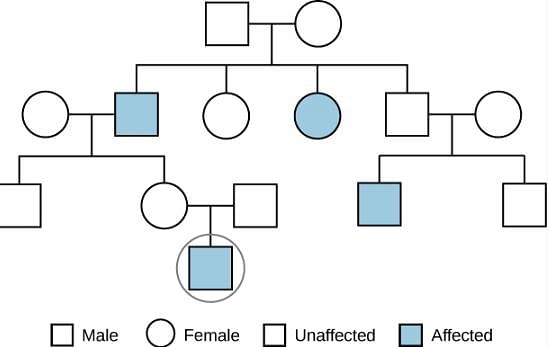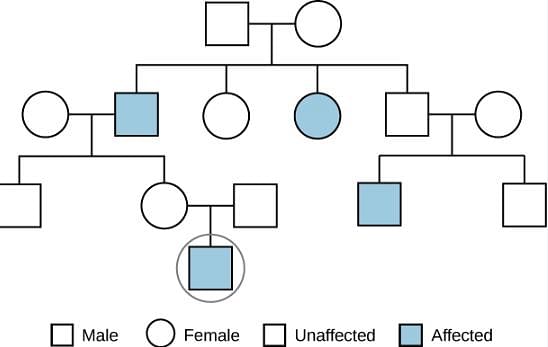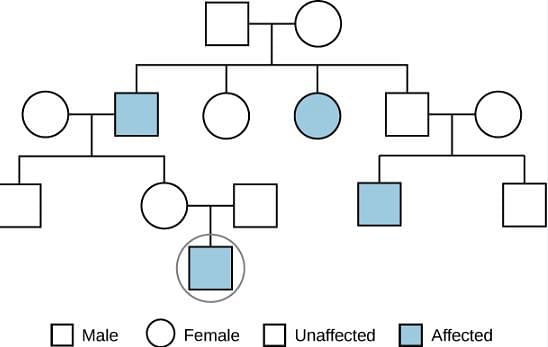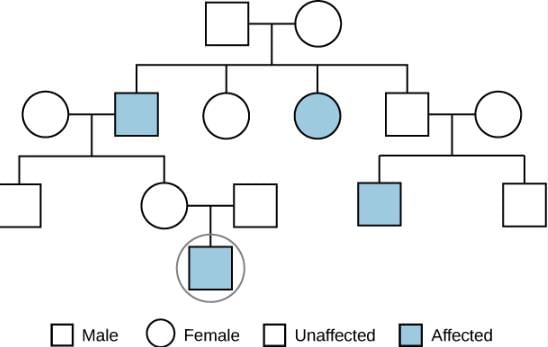Test: Biology - 8 - MCAT MCQ
15 Questions MCQ Test - Test: Biology - 8
Q. Based on the attached passage and chart, how would you know that the infant had neonatal ALD instead of X-linked ALD?
Adrenoleukodystrophy (ALD) is a genetic disorder in which lipids with very high molecular weights are not metabolized and accumulate within cells. Accumulation of these fats in the brain damages the myelin that surrounds nerves. This progressive disease has two causes: an autosomal recessive allele, which causes neonatal ALD, and a mutation in the ABCD1 gene located on the X chromosome. A controversial treatment is the use of Lorenzo’s oil, which is expensive; despite this treatment, neurological degradation persists in many patients. Gene therapy as a potential treatment is currently in trials but is also very costly. An infant patient exhibits symptoms of neonatal ALD, which are difficult to distinguish from the X-linked form of the disease. The infant’s physician consults electronic health records to construct a pedigree showing family members who also presented symptoms similar to ALD. The pedigree is shown in this diagram. The infant patient is circled. Symbols are filled when symptoms are present.


Q. ALD is a disorder that results in damage to the myelin that surrounds nerves. What type of symptoms would you expect to see in a patient with this disorder because of this damage? (You may consult the attached passage.)
Adrenoleukodystrophy (ALD) is a genetic disorder in which lipids with very high molecular weights are not metabolized and accumulate within cells. Accumulation of these fats in the brain damages the myelin that surrounds nerves. This progressive disease has two causes: an autosomal recessive allele, which causes neonatal ALD, and a mutation in the ABCD1 gene located on the X chromosome. A controversial treatment is the use of Lorenzo’s oil, which is expensive; despite this treatment, neurological degradation persists in many patients. Gene therapy as a potential treatment is currently in trials but is also very costly. An infant patient exhibits symptoms of neonatal ALD, which are difficult to distinguish from the X-linked form of the disease. The infant’s physician consults electronic health records to construct a pedigree showing family members who also presented symptoms similar to ALD. The pedigree is shown in this diagram. The infant patient is circled. Symbols are filled when symptoms are present.


| 1 Crore+ students have signed up on EduRev. Have you? Download the App |
Q. Tammy is a 37-year-old female affected with hemophilia A, an X-linked recessive disorder that affects blood clotting. Tammy marries Jason and they have one son. If Jason does not carry any copies of the hemophilia A gene, what are the chances that their son will have hemophilia A? (You may consult the attached passage.)
Adrenoleukodystrophy (ALD) is a genetic disorder in which lipids with very high molecular weights are not metabolized and accumulate within cells. Accumulation of these fats in the brain damages the myelin that surrounds nerves. This progressive disease has two causes: an autosomal recessive allele, which causes neonatal ALD, and a mutation in the ABCD1 gene located on the X chromosome. A controversial treatment is the use of Lorenzo’s oil, which is expensive; despite this treatment, neurological degradation persists in many patients. Gene therapy as a potential treatment is currently in trials but is also very costly. An infant patient exhibits symptoms of neonatal ALD, which are difficult to distinguish from the X-linked form of the disease. The infant’s physician consults electronic health records to construct a pedigree showing family members who also presented symptoms similar to ALD. The pedigree is shown in this diagram. The infant patient is circled. Symbols are filled when symptoms are present.


Q. Tracie is a 29-year-old female with Rett syndrome, a rare X-linked dominant neurological disorder. Tracie is heterozygous for the trait. She marries Jax and they have one daughter. If Jax does not carry any copies of the Rett syndrome gene, what are the chances that their daughter will inherit the gene for Rett syndrome? (You may consult the attached passage.)
Adrenoleukodystrophy (ALD) is a genetic disorder in which lipids with very high molecular weights are not metabolized and accumulate within cells. Accumulation of these fats in the brain damages the myelin that surrounds nerves. This progressive disease has two causes: an autosomal recessive allele, which causes neonatal ALD, and a mutation in the ABCD1 gene located on the X chromosome. A controversial treatment is the use of Lorenzo’s oil, which is expensive; despite this treatment, neurological degradation persists in many patients. Gene therapy as a potential treatment is currently in trials but is also very costly. An infant patient exhibits symptoms of neonatal ALD, which are difficult to distinguish from the X-linked form of the disease. The infant’s physician consults electronic health records to construct a pedigree showing family members who also presented symptoms similar to ALD. The pedigree is shown in this diagram. The infant patient is circled. Symbols are filled when symptoms are present.

Q. In prokaryotes, where is the DNA organized?
Prokaryotic DNA is arranged as a circular chromosome that is tightly coiled in the nucleoid region of the cell's cytoplasm. Genes involved in the same biochemical pathway or required for a specific function are grouped together in operons. An example of this is the lactose (or lac) operon, where all the genes needed for lactose metabolism are located in close proximity.
In prokaryotes, operon expression can be influenced by three types of regulatory molecules: repressors, activators, and inducers. Repressors are proteins that inhibit gene transcription in response to external stimuli, while activators are proteins that enhance gene transcription in response to external stimuli. Inducers, on the other hand, are small molecules that can either activate or inhibit gene transcription depending on the cell's needs and the availability of substrates.
In E. coli, the process of lactose digestion begins with the enzyme β-galactosidase breaking down lactose. The gene responsible for producing β-galactosidase, called lacZ, is part of an operon that is regulated in coordination with other genes involved in lactose utilization.
Q. What are operons?
Prokaryotic DNA is arranged as a circular chromosome that is tightly coiled in the nucleoid region of the cell's cytoplasm. Genes involved in the same biochemical pathway or required for a specific function are grouped together in operons. An example of this is the lactose (or lac) operon, where all the genes needed for lactose metabolism are located in close proximity.
In prokaryotes, operon expression can be influenced by three types of regulatory molecules: repressors, activators, and inducers. Repressors are proteins that inhibit gene transcription in response to external stimuli, while activators are proteins that enhance gene transcription in response to external stimuli. Inducers, on the other hand, are small molecules that can either activate or inhibit gene transcription depending on the cell's needs and the availability of substrates.
In E. coli, the process of lactose digestion begins with the enzyme β-galactosidase breaking down lactose. The gene responsible for producing β-galactosidase, called lacZ, is part of an operon that is regulated in coordination with other genes involved in lactose utilization.
Q. Which of the following is a protein that suppresses gene transcription in prokaryotes?
Prokaryotic DNA is arranged as a circular chromosome that is tightly coiled in the nucleoid region of the cell's cytoplasm. Genes involved in the same biochemical pathway or required for a specific function are grouped together in operons. An example of this is the lactose (or lac) operon, where all the genes needed for lactose metabolism are located in close proximity.
In prokaryotes, operon expression can be influenced by three types of regulatory molecules: repressors, activators, and inducers. Repressors are proteins that inhibit gene transcription in response to external stimuli, while activators are proteins that enhance gene transcription in response to external stimuli. Inducers, on the other hand, are small molecules that can either activate or inhibit gene transcription depending on the cell's needs and the availability of substrates.
In E. coli, the process of lactose digestion begins with the enzyme β-galactosidase breaking down lactose. The gene responsible for producing β-galactosidase, called lacZ, is part of an operon that is regulated in coordination with other genes involved in lactose utilization.
Q. What is the function of activators in prokaryotic gene expression?
Prokaryotic DNA is arranged as a circular chromosome that is tightly coiled in the nucleoid region of the cell's cytoplasm. Genes involved in the same biochemical pathway or required for a specific function are grouped together in operons. An example of this is the lactose (or lac) operon, where all the genes needed for lactose metabolism are located in close proximity.
In prokaryotes, operon expression can be influenced by three types of regulatory molecules: repressors, activators, and inducers. Repressors are proteins that inhibit gene transcription in response to external stimuli, while activators are proteins that enhance gene transcription in response to external stimuli. Inducers, on the other hand, are small molecules that can either activate or inhibit gene transcription depending on the cell's needs and the availability of substrates.
In E. coli, the process of lactose digestion begins with the enzyme β-galactosidase breaking down lactose. The gene responsible for producing β-galactosidase, called lacZ, is part of an operon that is regulated in coordination with other genes involved in lactose utilization.
Q. What are inducers in prokaryotic gene regulation?
Prokaryotic DNA is arranged as a circular chromosome that is tightly coiled in the nucleoid region of the cell's cytoplasm. Genes involved in the same biochemical pathway or required for a specific function are grouped together in operons. An example of this is the lactose (or lac) operon, where all the genes needed for lactose metabolism are located in close proximity.
In prokaryotes, operon expression can be influenced by three types of regulatory molecules: repressors, activators, and inducers. Repressors are proteins that inhibit gene transcription in response to external stimuli, while activators are proteins that enhance gene transcription in response to external stimuli. Inducers, on the other hand, are small molecules that can either activate or inhibit gene transcription depending on the cell's needs and the availability of substrates.
In E. coli, the process of lactose digestion begins with the enzyme β-galactosidase breaking down lactose. The gene responsible for producing β-galactosidase, called lacZ, is part of an operon that is regulated in coordination with other genes involved in lactose utilization.
Q. What are cell membranes primarily composed of?
Cell membranes are composed of phospholipids and serve as the boundary for cells. Phospholipids consist of a pair of fatty acids, which can have carbon-carbon double bonds or not, connected to a three-carbon glycerol with a phosphate group. The structure of phospholipids forms a bilayer with hydrophilic phosphate ends facing the outer and inner surfaces of the membrane, while the hydrophobic fatty acid chains extend into the space between these surfaces. This selectively permeable membrane facilitates the exchange of substances between the cell's interior and its environment.
Due to the hydrophilic and hydrophobic nature of the plasma cell membrane, only certain molecules can passively diffuse between the cell's interior and the environment. The fluidity of the membrane affects passive transport, and the presence of other molecules, such as cholesterol, can significantly impact its fluidity. Temperature also influences membrane fluidity. Researchers conducted measurements to compare the speed of oxygen molecules (O2) moving through three types of membranes (lens lipid, POPC/CHOL, and POPC) with their movement through water. These measurements were conducted at different temperatures.
Q. How are the hydrophilic phosphate ends of phospholipids oriented in the cell membrane?
Cell membranes are composed of phospholipids and serve as the boundary for cells. Phospholipids consist of a pair of fatty acids, which can have carbon-carbon double bonds or not, connected to a three-carbon glycerol with a phosphate group. The structure of phospholipids forms a bilayer with hydrophilic phosphate ends facing the outer and inner surfaces of the membrane, while the hydrophobic fatty acid chains extend into the space between these surfaces. This selectively permeable membrane facilitates the exchange of substances between the cell's interior and its environment.
Due to the hydrophilic and hydrophobic nature of the plasma cell membrane, only certain molecules can passively diffuse between the cell's interior and the environment. The fluidity of the membrane affects passive transport, and the presence of other molecules, such as cholesterol, can significantly impact its fluidity. Temperature also influences membrane fluidity. Researchers conducted measurements to compare the speed of oxygen molecules (O2) moving through three types of membranes (lens lipid, POPC/CHOL, and POPC) with their movement through water. These measurements were conducted at different temperatures.
Q. What is the role of cholesterol in the fluidity of the cell membrane?
Cell membranes are composed of phospholipids and serve as the boundary for cells. Phospholipids consist of a pair of fatty acids, which can have carbon-carbon double bonds or not, connected to a three-carbon glycerol with a phosphate group. The structure of phospholipids forms a bilayer with hydrophilic phosphate ends facing the outer and inner surfaces of the membrane, while the hydrophobic fatty acid chains extend into the space between these surfaces. This selectively permeable membrane facilitates the exchange of substances between the cell's interior and its environment.
Due to the hydrophilic and hydrophobic nature of the plasma cell membrane, only certain molecules can passively diffuse between the cell's interior and the environment. The fluidity of the membrane affects passive transport, and the presence of other molecules, such as cholesterol, can significantly impact its fluidity. Temperature also influences membrane fluidity. Researchers conducted measurements to compare the speed of oxygen molecules (O2) moving through three types of membranes (lens lipid, POPC/CHOL, and POPC) with their movement through water. These measurements were conducted at different temperatures.
Q. What is the primary factor that determines whether molecules can passively diffuse through the cell membrane?
Cell membranes are composed of phospholipids and serve as the boundary for cells. Phospholipids consist of a pair of fatty acids, which can have carbon-carbon double bonds or not, connected to a three-carbon glycerol with a phosphate group. The structure of phospholipids forms a bilayer with hydrophilic phosphate ends facing the outer and inner surfaces of the membrane, while the hydrophobic fatty acid chains extend into the space between these surfaces. This selectively permeable membrane facilitates the exchange of substances between the cell's interior and its environment.
Due to the hydrophilic and hydrophobic nature of the plasma cell membrane, only certain molecules can passively diffuse between the cell's interior and the environment. The fluidity of the membrane affects passive transport, and the presence of other molecules, such as cholesterol, can significantly impact its fluidity. Temperature also influences membrane fluidity. Researchers conducted measurements to compare the speed of oxygen molecules (O2) moving through three types of membranes (lens lipid, POPC/CHOL, and POPC) with their movement through water. These measurements were conducted at different temperatures.
Q. What did the researchers measure to compare the movement of oxygen molecules?
Cell membranes are composed of phospholipids and serve as the boundary for cells. Phospholipids consist of a pair of fatty acids, which can have carbon-carbon double bonds or not, connected to a three-carbon glycerol with a phosphate group. The structure of phospholipids forms a bilayer with hydrophilic phosphate ends facing the outer and inner surfaces of the membrane, while the hydrophobic fatty acid chains extend into the space between these surfaces. This selectively permeable membrane facilitates the exchange of substances between the cell's interior and its environment.
Due to the hydrophilic and hydrophobic nature of the plasma cell membrane, only certain molecules can passively diffuse between the cell's interior and the environment. The fluidity of the membrane affects passive transport, and the presence of other molecules, such as cholesterol, can significantly impact its fluidity. Temperature also influences membrane fluidity. Researchers conducted measurements to compare the speed of oxygen molecules (O2) moving through three types of membranes (lens lipid, POPC/CHOL, and POPC) with their movement through water. These measurements were conducted at different temperatures.
Which cellular component, found in both prokaryotic and eukaryotic cells, is the site of protein synthesis in the cell?

















